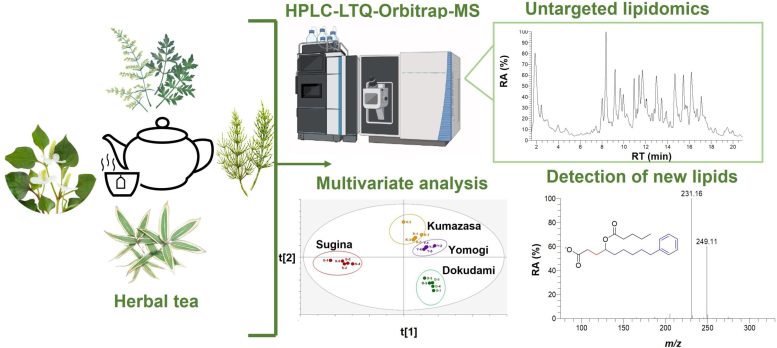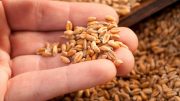
Researchers at Hokkaido University have for the first time identified a wide range of lipids in four types of herbal teas, uncovering new compounds with potential health benefits. These findings suggest that lipids may play a significant role in the medicinal properties of teas, including gut health and anti-inflammatory effects. The study used advanced techniques to differentiate lipid types and discovered new bioactive compounds, paving the way for further research on over 40 types of herbal teas.
A groundbreaking study has revealed diverse and previously unidentified lipids in herbal teas, suggesting significant health implications and opening avenues for further nutritional research.
The lipids in some herbal teas have been identified in detail for the first time, preparing the ground for investigating their contribution to the health benefits of the teas.
Herbal teas are enjoyed worldwide, not only for their taste and refreshment but also for a wide range of reputed health benefits. But the potential significance of a category of compounds called lipids in the teas has been relatively unexplored. Researchers at Hokkaido University, led by Associate Professor Siddabasave Gowda and Professor Shu-Ping Hui of the Faculty of Health Sciences, have now identified 341 different molecular species from five categories of lipids in samples of four types of herbal tea. They published their results in the journal Food Chemistry.

The four types of herbal tea investigated in this study for their bioactive lipids. Credit: Siddabasave Gowda
Lipids are a diverse collection of natural substances that share the property of being insoluble in water. They include all of the fats and oils that are common constituents of many foods, but they have generally not been examined as significant components of teas.
The Hokkaido team selected four teas for their initial analysis: dokudami (Houttuynia cordata, fish mint), kumazasa (Sasa veitchii), sugina (Equisetum arvense, common horsetail) and yomogi (Artemisia princeps, Japanese mugwort).
Medicinal Benefits and Analytical Techniques
“These herbs are native to Japan and have been widely consumed as tea from ancient times due to their medicinal properties,” says Gowda. The medicinal benefits attributed to these and other herbal teas include antioxidant, antiglycation, anti-inflammatory, antibacterial, antiviral, anti-allergic, anticarcinogenic, antithrombotic, vasodilatory, antimutagenic, and anti-aging effects.

Separation and analysis revealed the lipid profiles of four herbal teas. Credit: Lipsa Rani Nath, et al. Food Chemistry. March 4, 2024
The lipids in the teas were separated and identified by combining two modern analytical techniques called high-performance liquid chromatography and linear ion trap-Orbitrap mass spectrometry.
Significant variations in the lipids in the four types of tea were revealed in the analysis, with each type containing some known bioactive lipids. These included a distinct category of lipids called short-chain fatty acid esters of hydroxy fatty acids (SFAHFAs), some of which had never previously been found in plants. SFAHFAs detected in tea could be a novel source of short-chain fatty acids, which are essential metabolites for maintaining gut health.
“The discovery of these novel SFAHFAs opens new avenues for research,” says Hui, adding that the lipid concentrations found in the teas are at levels that could be expected to have significant nutritional and medical effects in consumers.

From left: Siddabasave Gowda, Divyavani Gowda, Lipsa Rani Nath, Shu-Ping Hui (Hokkaido University), and Hitoshi Chiba (Sapporo University of Health Sciences) of the research team. Credit: Siddabasave Gowda
The lipids discovered also included α-linolenic acid, already known for its anti-inflammatory properties, and arachidonic acid which has been associated with a variety of health benefits. These two compounds are examples of a range of poly-unsaturated fatty acids found in the teas, a category of lipids that are well-known for their nutritional benefits.
“Our initial study paves the way for further exploration of the role of lipids in herbal teas and their broad implications for human health and nutrition,” Gowda concludes. “We now want to expand our research to characterize the lipids in more than 40 types of herbal tea in the near future.”
Reference: “Dissecting new lipids and their composition in herbal tea using untargeted LC/MS” by Lipsa Rani Nath, Siddabasave Gowda B. Gowda, Divyavani Gowda, Fengjue Hou, Hitoshi Chiba and Shu Ping Hui, 4 March 2024, Food Chemistry.
DOI: 10.1016/j.foodchem.2024.138941
The study was funded by the Japan Society for the Promotion of Science and the Japan Science and Technology Agency.









Be the first to comment on "Hidden Nutrients Revealed: Groundbreaking Study Identifies Lipids in Herbal Teas"